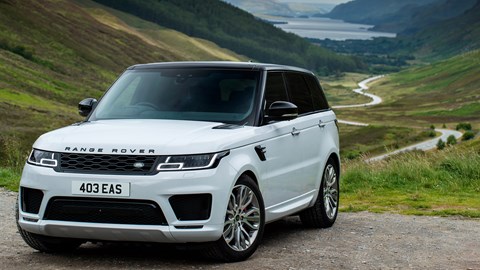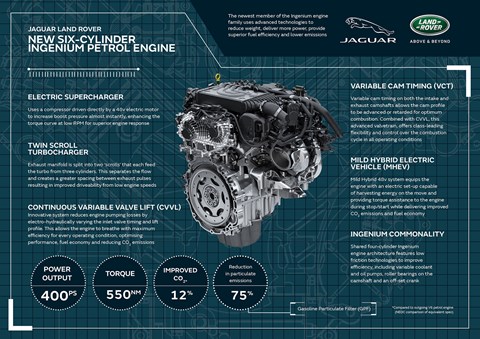► New tech: JLR’s straight six petrols and diesels
► Inline mild hybrids replace V6/V8 range
► Aim: lighter, smoother, cleaner
Most recently it was Mercedes-Benz, now Jaguar Land Rover is switching back from a V6 to an inline six-cylinder petrol engine – the configuration once used by the classic E-type and XJ-S. The new 3.0-litre turbocharged petrol and diesel unit, which features 48-volt mild-hybrid technology, debuted in petrol form in 2019, as a diesel in the Range Rover Sport in July 2020 (below).
Effectively a four-cylinder with two extra cylinders, the new inline-six represents a logical extension – literally – of JLR’s modular four-cylinder aluminium Ingenium petrol and diesel engines, introduced in 2015 and produced at the company’s Wolverhampton engine manufacturing plant. Benefits compared with a V6 include fewer parts – an inline-six has a single cylinder head, not two – economies of scale unlocked by sharing parts with the smaller Ingenium engines, and smoother power delivery.

The inline-six’s combination of 83mm bore and 92mm stroke is identical to four-cylinder Ingenium engines, and output is boosted by a twin-scroll turbocharger plus another compressor driven by an electric motor, which helps eliminate lag. Power for the petrol version peaks at 395bhp, torque at 406lb ft, where JLR’s beefiest supercharged V6 currently makes 375bhp/339lb ft in the F-Type.
Fuel efficiency is boosted by a 48-volt mild hybrid system. It harvests energy under braking, stores it in a battery, and can redeploy it, for instance when moving away after the stop-start system has killed the engine at the lights. Land Rover quotes 24.5-26.7mpg and 213g/km on the new WLTP test cycle.
The engine itself is 20kg lighter than the old V6, but that’s cancelled out by the extra weight of the mild-hybrid technology.
Other JLR models continue to use the V6 supercharged engine and turbodiesel V6s too, but inline Ingenium sixes are set to be phased in universally over time. Higher up the foodchain, BMW-sourced V8 bi-turbos will replace today’s Ford-sourced supercharged V8.

Why a straight six?
Advantages of inline-six engine include fewer parts than a V6, plus a smoother, more refined power delivery. Ingenium six is all-aluminium, with roller bearings on the camshaft and balancer shaft, plus variable coolant and oil pumps.
Turbo time
3.0-litre engine is boosted by twin-scroll turbo, plus an Audi SQ7-style electric compressor designed to fill the small amount of turbo lag still experienced in modern engines – it’s claimed to fully spool up to 120,000rpm in 0.5 seconds. Total output is 395bhp and 406lb ft.
Variable valves
CVVL (continuous variable valve lift) reduces pumping losses by varying inlet valve timing and lift, maximising efficiency in combination with VCT (variable cam timing) which optimises both intake and exhaust camshafts.
Longer stroke
3.0-litre capacity is unchanged from outgoing supercharged V6 engine but bore is smaller at 83mm (down from 84.5) and stroke is up from 89 to 92mm. The longer stroke lends itself to torquier, less revvy delivery.
Mild hybrid
48-volt system harvests surplus energy under braking, stores it in a battery, and redeploys it for smooth, quick engine restarts during stop/start driving, which contributes to cleaner, more economical running.
HST package
Aside from the new engine, the £81,250 HST also gets carbonfibre exterior trim, multi-adjustable front seats, suedecloth on the steering wheel and gearlever, red brake calipers and extra electronic safety aids.
More car tech stories